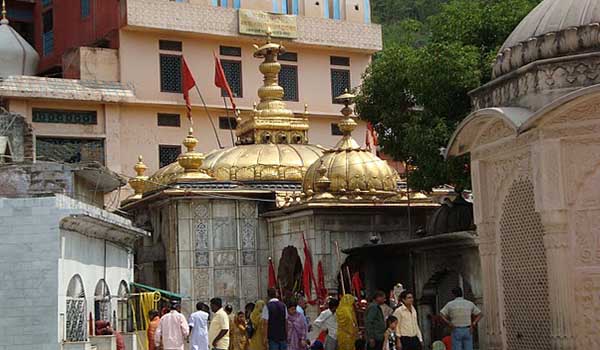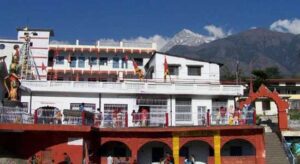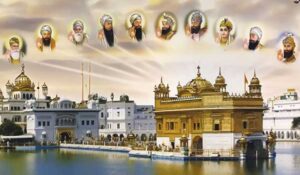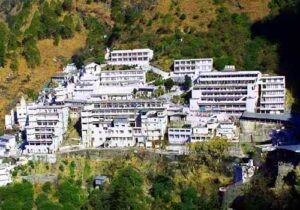The flaming temple of Himachal Pradesh, Jwalaji temple is located at a distance of 34 km south of Kangra Valley. The Jawalaji temple is considered very powerful, and count as one of the 51 Shakti-Pitha temples in India. It is here that Sati’s tongue fell which can now be seen in the form of the flame.
The ancient temple, built against a wooded spur, has a dome that was glided by Maharaja Ranjit Singh. Pilgrims consider an eternally burning flame emanating from a hollow rock in the sanctum to be a manifestation of goddess Devi. The temple comes alive with Nawaratra celebrations and colourful fairs during March-April and Sept-Oct every year. The famous Jwalamukhi Temple is about 56 km from Dharamsala in the Valley of Beas. The goddess is manifest here as tiny blue flames and worshiped as such. There is a musical fountain here which is a pleasure to watch during nights.
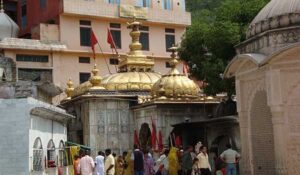 The Jwalamukhi Temple in Kangra District of Himachal is considered extremely sacred for the Hindus. The legend of the Jwalamukhi Temple relates to Sati. Here the goddess is manifested as tiny flames that burn through the fissures in the age old rock. The temple of Jwalamukhi is not an architectural delight. Moreover, there is no idol to worship too. Unlike any other temple, this one doesn’t have a statue or an image, but a constantly burning blue flame that seems to come from the rocks. Jwalamukhi Temple is a temple of the Goddess of Light. Jwalamukhi is also known as the Flaming Goddess or She of the Flaming Mouth. The building has a gilt dome and a silver plated folding doors. Inside, there is a 3 feet square pit with pathway all around. In the centre, there is a hollowed rock over a primary fissure of flame. This one is regarded as the mouth of the Mahakali. Flames emit out from several other point in the pit. They are nine in total and represent the different form of the goddess – Saraswati, Annapurna, Chandi, Hing Laj, Vindhya Vasini, Mahalakshmi, Mahakali, Ambika and Anjana. There are two lions in front of the temple.
The Jwalamukhi Temple in Kangra District of Himachal is considered extremely sacred for the Hindus. The legend of the Jwalamukhi Temple relates to Sati. Here the goddess is manifested as tiny flames that burn through the fissures in the age old rock. The temple of Jwalamukhi is not an architectural delight. Moreover, there is no idol to worship too. Unlike any other temple, this one doesn’t have a statue or an image, but a constantly burning blue flame that seems to come from the rocks. Jwalamukhi Temple is a temple of the Goddess of Light. Jwalamukhi is also known as the Flaming Goddess or She of the Flaming Mouth. The building has a gilt dome and a silver plated folding doors. Inside, there is a 3 feet square pit with pathway all around. In the centre, there is a hollowed rock over a primary fissure of flame. This one is regarded as the mouth of the Mahakali. Flames emit out from several other point in the pit. They are nine in total and represent the different form of the goddess – Saraswati, Annapurna, Chandi, Hing Laj, Vindhya Vasini, Mahalakshmi, Mahakali, Ambika and Anjana. There are two lions in front of the temple.
First built by the Sikh Raja Kharak Singh, the temple is ornate and heavily embellished with a gilt dome, lots of gold and decorated pinnacles. The doors to the temple are of pure silver and of such beauty that Lord Harding is said to have had a copy made for himself. A canal channels the spring waters which come from a different source around the back of the temple and another local story states that the Emperor Akbar built this canal in an attempt to put out the flames in the temple. When it didn’t work, he became an ardent devotee himself. In fact one of the local women’s songs has lyrics that describe how Akbar came to the temple and placed his gold crown near the flames. The Goddess turned the gold to copper.
Legend of Jwalamukhi Temple
The legend of the Jwalamukhi Temple relates to Sati, who was born when gods concentrated their individual energy on the ground. These gods were looking for a respite from the atrocities of the demons. This girl was Adishakti or the first shakti (Sati or Parvati). She was brought up in the house of Prajapati Daksha and married Lord Shiva later. It is believed that Prajapati Daksha once organised a yajna and invited everyone barring Lord Shiva. Sati felt immensely humiliated at this act of her father and immolated herself in the fire of the havankund. On hearing this, Lord Shiva became so furious that he carried Sati’s burnt body and moved around the three world. The gods could foresee a calamity approaching so they assembled before Lord Vishnu and asked him to do something to diffuse the anger of lord Shiva. Lord Vishnu cut apart Sati’s body into several pieces with his Sudharshan Chakra. Wherever on earth the pieces of Sati’s body fell, a shaktipeeth came up. These are the spot that are regarded as the power centre of the goddess. The Jwalamukhi temple is the place where the tongue of Sati fell. Here the goddess is manifested as tiny flames that burn through the fissures in the age old rock. The temple is supposed to be first built by a king who, on the complain of a cowherd, tried to find out the place where from where a female emerged and drank the milk of the cow. Since, the king was aware of the legend of Sati, he continued his search for the place and finally succeeded. He constructed a temple there and employed priest to perform pujas. Later, Pandavas came and carried out some renovation work in the temple. According to one legend, Lord Shiva conquered the Demon Jalandhara by burying him with mountains. The flames are believed to come from his mouth.
History of Jwalamukhi Temple
As perhistory, once the great Mughal emperor Akbar visited this temple and tried to douse of the flame of the temple. However, when unsuccessful, he willingly submitted to the power of the goddess. He presented a gold chhatri (umbrella) for the goddess which is said to have turned into copper when he turned around to have a look at it before leaving. Maharaja Ranjit Sigh also paid a visit to the temple in the year 1809. His son, Kharak Singh gifted a pair of silver plated folding doors to the temple while Ranjit Singh himself gave the gilt roof. Moreover, in the princely era, the work of the temple was managed by the raja of Naduan. He himself appointed the temple priest. After independence, things changed a lot. The pujaris is now appointed and paid by by the government. A part of the money collected by the temple is used to improve the facilities for the visiting pilgrims.
Devotees who worship the Goddess here believe that Jwalamukhi Mata will grant any wish, any desire and many songs are composed in honour of Jwalamukhi Devi and sung on the walk to the temple.
